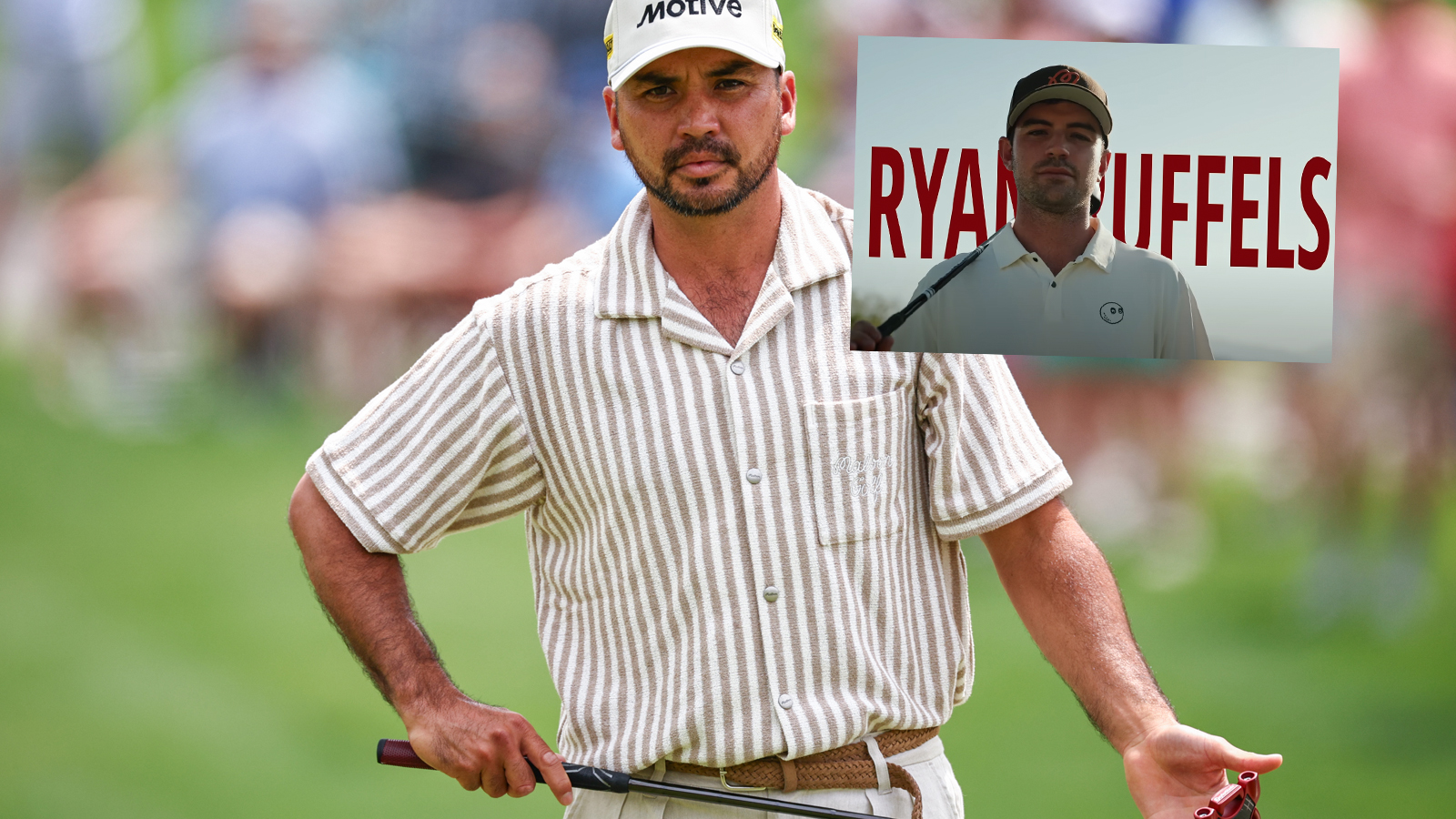Nepal: Golf High – Australian Golf Digest

- by Admin
- November 12, 2024

A daring journey to Nepal to play the world’s highest golf course at 15,239 feet
As I watch from the back seat of our Jeep, a Nepali policeman in a bright-orange rainsuit and motorcycle helmet signals us to wait. He looks hundreds of feet above us, up into the rain, “reading the greens” of the upper slopes – checking for boulders. I hope he’s a good boulder-reader because our lives are in his hands. He gives our driver a casual “go” signal, and our Jeep begins squelching forward through the mud-soup with a long train of Jeeps behind us.
“It’s clear?” I nervously ask Deepak Acharya, who’s sitting in the front passenger seat.
“He’s saying yes,” Acharya says calmly. Landslides are a way of life in Mustang, Nepal, during monsoon season.
“OK,” I say, relieved.
Suddenly, the policeman and another helmeted man next to him furiously motion for us to stop. A golf-bag-size rock comes crashing down 20 feet in front of us. “Oh, my God,” I breathe.
The hand signals now switch from “Stop” to “Go! Go! Go!” and we roar past the unstable area. The policeman smiles at me as we pass.
This is a lot for a golf tournament.
Mahendra Mainali, my golf buddy in Kathmandu, was the first to tell me about Mustang Golf Course, a new nine-holer in the remote Upper Mustang region of Nepal at 15,239 feet with an intoxicating claim to fame: when it opened on August 27, 2022, it became the world’s highest golf course. For years, the highest had been in Sikkim, India, on an Indian Army base. The 18-hole Yak Golf Course at 13,025 feet came with a yak-size problem: being a military course, it was effectively off-limits to civilians. For years, I had been trying to get on. Golf in unexpected places has consumed me for the past decade. Meeting other golf obsessives in far-flung pockets of the planet, bonding over a shared love of graphite and Peter Oosterhuis, always makes me happy. I’ve played in the Mongolian National Open, in the Australian Outback on the world’s longest course (Nullarbor Links, a five-day commitment with each hole about 50 miles from the next) and under the midnight sun in Iceland’s Arctic Open. I’ve hit a golf ball from Everest Base Camp in Nepal and played in the world’s highest golf tournament. But my leads for Yak Golf Course always went cold. Now Nepal – a country with eight of the world’s 10 tallest mountains – had performed a high-altitude rescue. The world’s highest golf course had moved from India to the land of Everest, and I had an invite to the launch.
On August 19, I stood in line at JFK Airport in New York, backpack full of golf balls, for my 14-hour flight to Doha with continuing service to Kathmandu. I would be in Nepal in 22 hours, the lone American in the 36-player “Top of the World Golf Classic”. Behind me was an elderly Nepali man in a wheelchair, a traditional yellow khata scarf (given by family and friends for good luck before journeys) draped around his neck. Down the check-in line, I spied yellow scarves tied to suitcase handles. This was my first adventure since the death of my father, playwright Israel Horovitz, to kidney cancer in November 2020. It had been a long time since golf was on my mind.
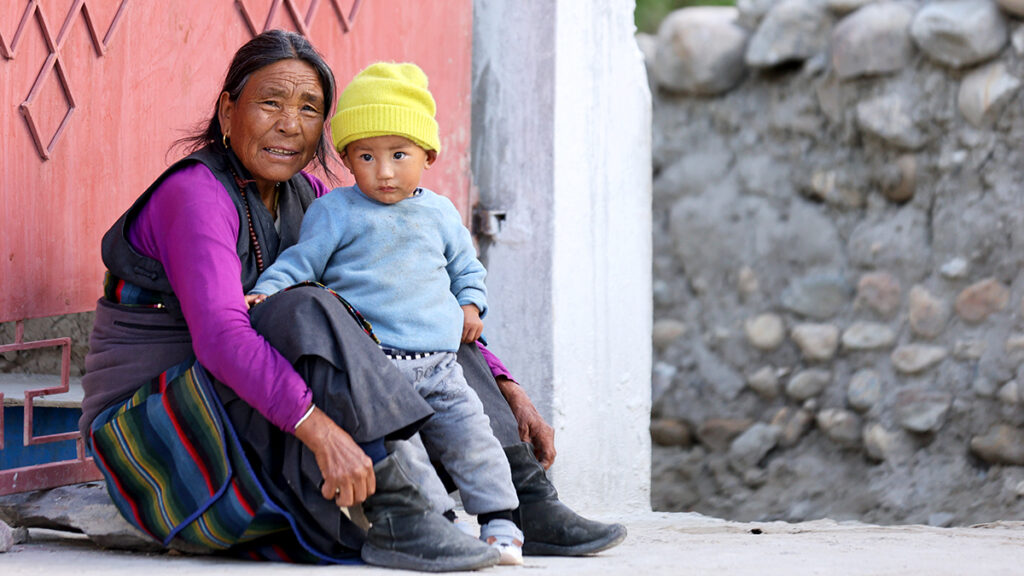
Of the 31 million people iN NEPAL, only 1,200 are golfers. Of these, 70 are professionals on the Surya Nepal Golf Tour (eight events last season, with purses of about $US4,000 to $US11,000. Sukra Bahadur Rai, a past Order of Merit winner, is now a regular on the Professional Golf Tour of India). With the creation of Mustang Golf Course, Nepal now has seven courses, the oldest of which, the par-68, 5,410-yard Royal Nepal Golf Club, dates to 1917.
Mustang was the idea of politician Indra Dhara Bista, a charismatic member of parliament for Gandaki Province. Bista was visiting, of all places, Arizona, when he remembered a finger-like shelf of land high above Mustang’s capital of Lo Manthang, seldom visited, used for grazing horses. In a flash familiar to any golfer who has looked at a field, hill or in-law’s garden and mentally planted some Poa annua, Bista thought, Wait, there could be a golf course here. He used one million Nepali rupees (about $US8,000) from the Constituency Infrastructure Development Fund to build Mustang.
The goal for Mustang Golf Course is for it to become a prime item on adventurous golfers’ bucket lists. As Everest does for climbers, the course would bring visitors to Nepal’s Mustang region and crucial aid to Nepal in its long comeback from the pandemic – a period of economic pain that saw a near halt in international tourism. I also sensed another reason behind Mustang’s construction, one born of the grab-life-by-the-back-tees gusto I saw in so many of my Nepali friends. Why not have the world’s highest golf course in Nepal? That spirit is why I was here. Sure, I wanted to see Mustang with my own eyes and feel what it is like to play nine holes above 15,000 feet. But after two unpleasant years of the pandemic, I needed a dose of my Nepali friends’ zest for life.
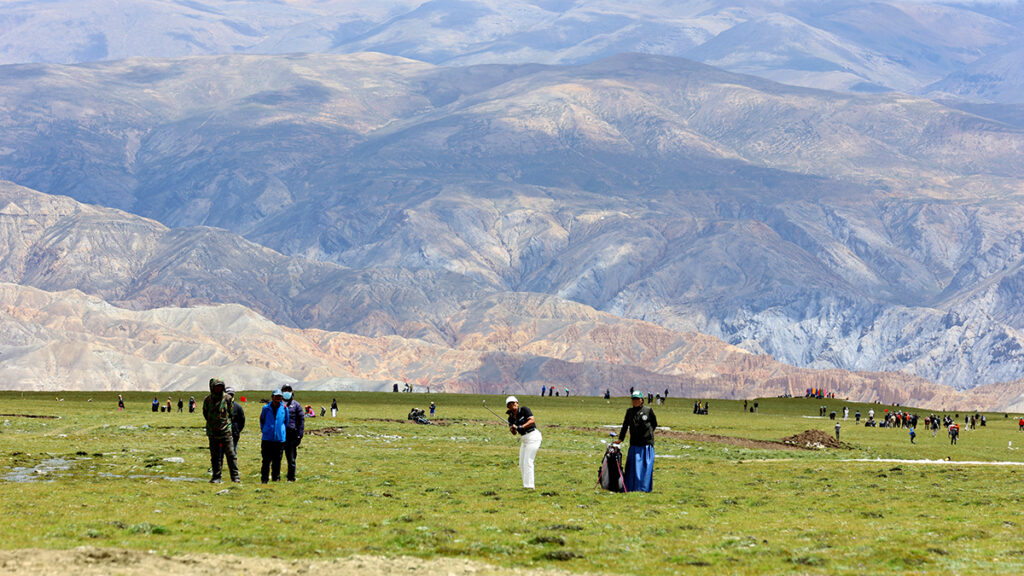
Inside the chaotic domestic terminal of Kathmandu’s Tribhuvan International Airport, awaiting a Yeti Air flight to the lakeside city of Pokhara, the launching pad for our golf expedition, golfers were assembling on a sticky monsoon season morning. “Ollie! How are you, my friend?”
Mainali, a lawyer and golf fanatic, gave me a big hug. Acharya, senior golf director at Gokarna Forest Resort and our tournament organiser, walked up with a grin and a competitors’ sheet. Others joined, sipping “milk coffee” and wearing Titleist hats, dressed as if they were about to tee off in an hour, which, it turned out, we were. Once we landed in Pokhara (a 25-minute flight), everyone would head to Himalayan Golf Course, just outside town, for a practice round. That the group would be doing this before checking into hotel rooms was an urge I understood. Himalayan Golf Course, inside a 1,000-foot gorge, evoked the fantasy course in Golden Tee Golf, but first I had to pick up my trekking permits, acetazolamide (Diamox) and dexamethasone for the coming altitude – standard tournament preparations at this height.
In 48 hours we would go from Pokhara’s 2,697 feet to Mustang’s 15,239 feet. To combat AMS (Acute Mountain Sickness), I would take 125 milligrams of Diamox twice daily to reduce headaches and breathlessness, with pronounced side-effects of finger tingling and constant peeing. I also had to take care of permits. Upper Mustang, closed to foreigners until 1992, requires a $US500 restricted-area trekking permit for entry that grants 10 days of access. I also had to obtain an Annapurna Conservation Area Permit and a Trekker Information Management System card at Pokhara’s Nepal Tourism Board office – why I’d packed a pile of passport photos.
“Have you ever been to Mustang?” Shyam Tamang, one of the golfers, asked.
“First time.”
The man’s eyes widened. “Oh!” he said. “You’re going to heaven.”
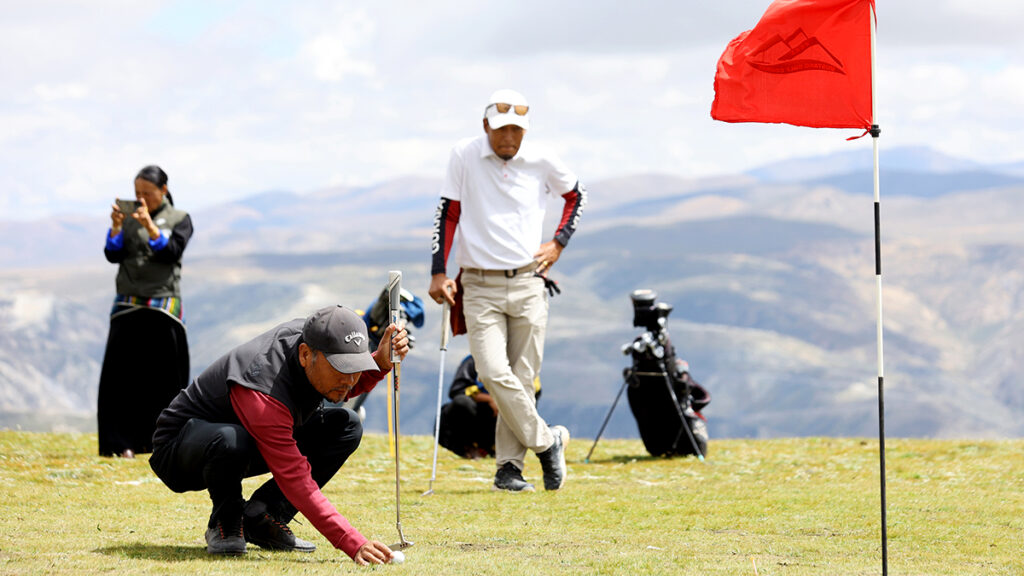
The Upper Mustang region of Nepal was once the ancient Kingdom of Lo, founded by King Ame Pal in 1380. The region is home to the Loba people, population 7,000. Lo Manthang, the walled capital city of Upper Mustang, above which the golf course was built, is 12 miles from the Tibetan border. Such proximity, combined with the region’s history of few visitors, makes Upper Mustang one of the last strongholds of Tibetan culture in Nepal. Lo Manthang teahouses serve traditional Tibetan butter tea (reputed to prevent chapped lips). Residents practise Tibetan Buddhism of the Sakya lineage and wear traditional Tibetan cloaks called chubas. Seldom-seen snow leopards prowl the land.
The Nepali golfers in my group were mostly in their 40s, 50s and 60s – business owners, retired police chiefs, high-ranking government employees, a few retired members of the military – and all obsessed golfers. “Many have been ringing these past few days, trying to get in [the tournament] last minute,” Acharya told me. (As general secretary for Nepal’s Professional Golfers Association, Acharya was our de facto trip captain.) “We’re planning on holding the award ceremony at the course,” Acharya said. “We’ll see how everyone reacts to the altitude.”
It was a muggy morning in Pokhara as we loaded into the Jeeps outside our hotel. Our 10 drivers, all Upper Mustang residents, most in their mid-20s with families waiting in Lo Manthang, wore matching white long-sleeve Mustang Golf Course shirts and green golf caps. Our drivers loaded the golf travel bags and tied them under tarps. Passing locals gave us quizzical looks. We were a travelling road show with ball-marker hat clips. Amid the hubbub, I spotted Dr Rita Thapa, 81, a Royal Nepal Golf Club member and our tournament’s honorary starter. Thapa, a former WHO director and pioneer in Nepal’s public health, was making this trip despite altitude concerns from her family, including her husband, the former Nepali ambassador to the United States. “I’ll be fine,” Thapa assured me. “I just hope I hit it well.”
Our driver – a stern-looking fellow with a ponytail and a denim jacket – whistled. We slammed Jeep doors closed and set off. Outside, the land was wet and thick around us, but shards of mountain peaks poked high above clouds and sparkled in the sky. Nepali folk music sang from our Jeep radio. We steadily overtook all cars and buses and motorbikes. I grew confident our driver had never been passed by another vehicle in his life.
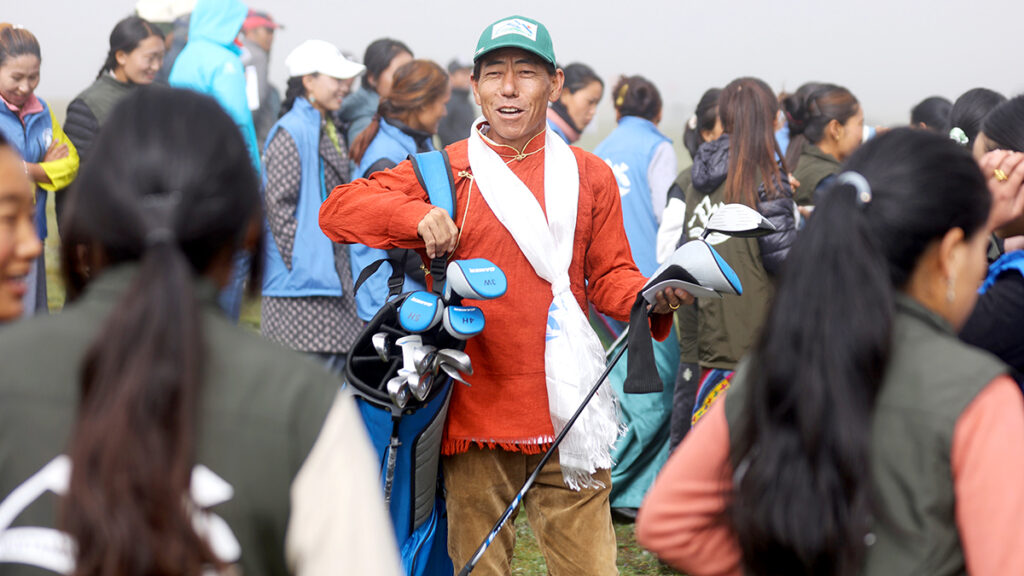
There are easier ways to get to Lo Manthang than two days of driving in monsoon season. We could have taken helicopters ($US125 per person for a four-person trip) or the 18-minute plane ride from Pokhara to Jomsom, halfway to Lo Manthang, skipping all the muddy road sections. We also could have played this tournament outside monsoon season (June to August) when roads are perfect. But Jeeps were what we had chosen,
August 27 was our tournament date, and nobody seemed concerned. The Nepali phrase ke garne – meaning “What is there to do?” – came to mind.
We passed the town of Kande, launching point for the famous Annapurna Base Camp trek (a popular alternative to the Everest Base Camp trek). Soon the blacktop road ended, and we bounced along a dirt road that didn’t even exist 25 years ago. Now it runs from Pokhara to the Chinese border at Korala, bringing increased trade, tourism and the modern world to Mustang. Trekkers supposedly used a path near this road, although we saw none. Trekking in Nepal largely hibernates until the clear, crisp days of October and November, with a second trekking window in April and May. (Nepali golfers, however, churn straight through the torrential rains of monsoon season – including one group of retired army majors with a weekly game at Royal Nepal called Monsoon Madness.)
In Mustang, the landscape changed, and the lush vegetation gave way to Utah-like desert and hills. The temperature dropped. We hugged the roaring Kali Gandaki River, its waters swollen from the rains, and rumbled through villages, passing schoolkids shouting “Namaste!” (Nepali for hello). We were driving through the Himalayas, crossing the iconic mountain range on our line for Lo Manthang.
As the sun set, we pulled into our home for the night, the Dragon Hotel in the former fortress town of Kagbeni (elevation: 9,199 feet). This was the entrance to the restricted area of Upper Mustang. Blue sheep, a major prey of snow leopards, grazed high on hills above us. Fields of buckwheat rustled in the wind. I already felt breathless from the altitude. Our group unloaded, stretched (I caught a few private practice swings and wrist-hinge checks among our group) and then headed to the dining hall for a Nepali meal of rice, meat and vegetables. I dined beside Deepak Magar, a 54-year-old golf pro at Royal Nepal, one of five professionals accompanying our group. Magar turned pro when he was 25, playing on and off the Professional Golf Tour of India. He had 10 wins, most of them in Nepal. Now he gives swing lessons. Many of his dedicated students were on this trip.
As second helpings were served, conversation at our table turned to golf. Someone mentioned playing at Royal Thimphu Golf Course in the nearby country of Bhutan. “Have you played golf in Bhutan?” I asked Magar.
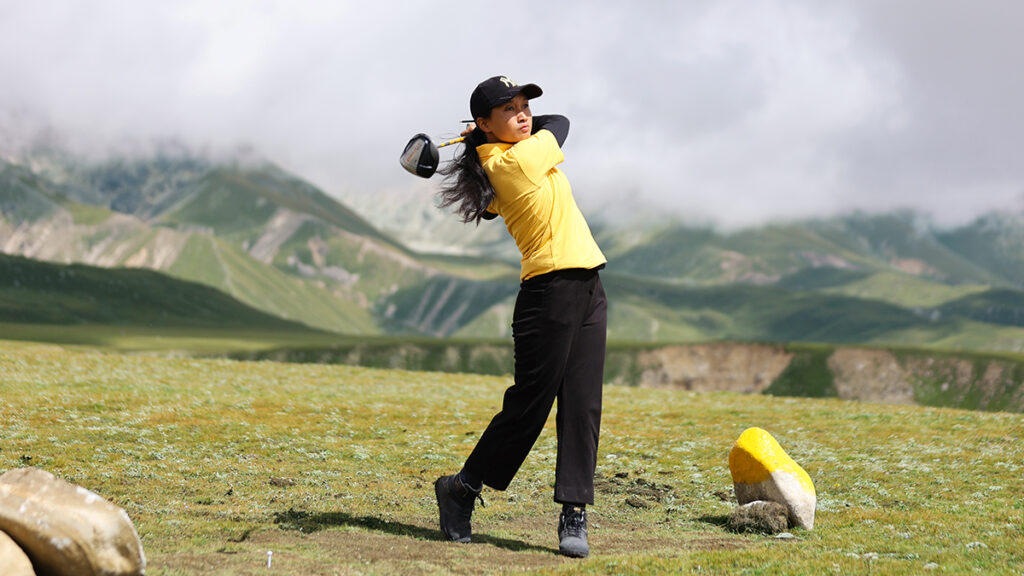
The pro paused, lost in a memory. “In 1993,” he replied softly, “I won the Bhutan Open.”
Nepalis are perhaps bestknown for two professions. The high-altitude climbing Sherpa people, based in the Solukhumbu region of Nepal, established themselves as fearless and talented mountaineers and high-altitude porters, doing battle each season with fierce weather to put clients on distant peaks. (One Royal Nepal member, a 9-handicapper named Ang Norbu Sherpa, has summited Everest four times. A photograph of him holding the RNGC emblem atop Everest’s summit hangs in the clubhouse.) Also globally revered are the Nepali Gurkha soldiers of the British Army, who still serve today. The name originates from the Nepali hill town of Gorkha, and they have served in the British Army for more than 200 years, including both World Wars, developing a reputation for stunning bravery. Decorated field marshal Sam Manekshaw once said, “If a man says he is not afraid of dying, he is either lying or is a Gurkha.”
Before driving to Lo Manthang the next morning, we had an important pre-tournament stop: the Muktinath Temple at the base of the Thorong La mountain pass at 12,171 feet is a sacred site for Hindus and Buddhists. Mukti means “release” in Nepali; Hindus from Nepal (and India) try to visit Muktinath at least once in their lives, seeking release from whatever burdens them. The excitement of our group approaching Muktinath rivalled that of a foursome playing Augusta National Golf Club for the first time. Everyone rushed up the hundreds of steps to the temple – no small task in the altitude. I hung back, carefully climbing alongside Thapa and Major Bejoy Moktan, 76, a high-ranking Gurkha officer with whom I’d played golf at Himalayan Golf Club in 2016. Thapa reached a giant prayer wheel and gazed out in wonder. “If heaven were on Earth, it would be here.”
The temple was thrumming with activity; 108 brass taps lined the perimeter, releasing a stream of frigid holy water, under which visitors ran, splashed heads and filled bottles to bring back for family members. I walked through the temple grounds beside Thapa. Without warning, I started thinking of my dad, who had been my biggest supporter, golf sidekick and best friend. I thought of how proud he would have been of me for being on this trip, and all the heartache I’d been holding in the past two years came pouring out. Thapa saw me crying, and I choked through an explanation. She patted me on the shoulder. “Light a candle in here for your dad,” she said tenderly, beckoning to a room filled with candles. “Think of happy memories of him.”

The city of Lo Manthang, Upper Mustang’s capital, stretches out over a windswept valley at 12,598 feet. Its whitewashed walls hold a 600-year-old royal palace. As far back as the 1400s – while golf balls were being struck in St Andrews – Lo kings ruled from this perch. Today, 900 people call Lo Manthang home. This was our tournament base camp.
Inside the local community hall at our tournament welcome dinner, golfers passed around Tibetan biscuits called khapse. On the wood stage, beneath a string of prayer flags, 10 traditionally dressed women met my gaze. They were members of the Mothers Group local association hosting our dinner. The women sipped butter tea and smiled at us. By the door, 10 locals peered in excitedly. The show had arrived in town.
Politician Bista, wearing a cowboy hat and bright smile, made a jovial speech, welcoming all participants to Lo Manthang. Association members poured local Nepali wine into glasses and served from a buffet of dal bhat (a Nepali food staple). Worrying about tomorrow’s altitude, I declined the wine. I wanted to be sharp.
At the front of the room, Acharya announced tomorrow’s format: nine holes, shotgun start at 9am to beat fierce afternoon winds, Stableford scoring system (at three-quarter handicaps) with prizes for closest-to-the-pin, low gross and longest drive.
Bhuwan Gurung, general manager of Pokhara’s Himalayan Golf Course, was next to me in the buffet line. “How are you feeling, sir?” he asked.
“A little short of breath, but not bad,” I replied.
“Good. Drink lots of hot tea for your strength.” Gurung had been in Lo Manthang for three days, making the 30-minute drive to the course at 6 each morning. There, he spent hours top-dressing and hand-cutting Mustang’s greens. During the past few months, he had spent 17 days up at Mustang.
I asked what the locals thought. “Before, we had 15 Lo Manthang locals hitting shots for the first time at the course!” he smiled. “At first, they didn’t know what we were making. I gave them training. We brought some balls. Some people hit nice shots, too!”
Our gaggle of golfers sat together, fingers tingling from Diamox, eating lentils. I sat next to Mainali. Across the room, a few of our drivers wore blue World’s Highest Golf Course vests. Said Mainali, “Our drivers are all saying, ‘You better let us hit shots up at the course!’”
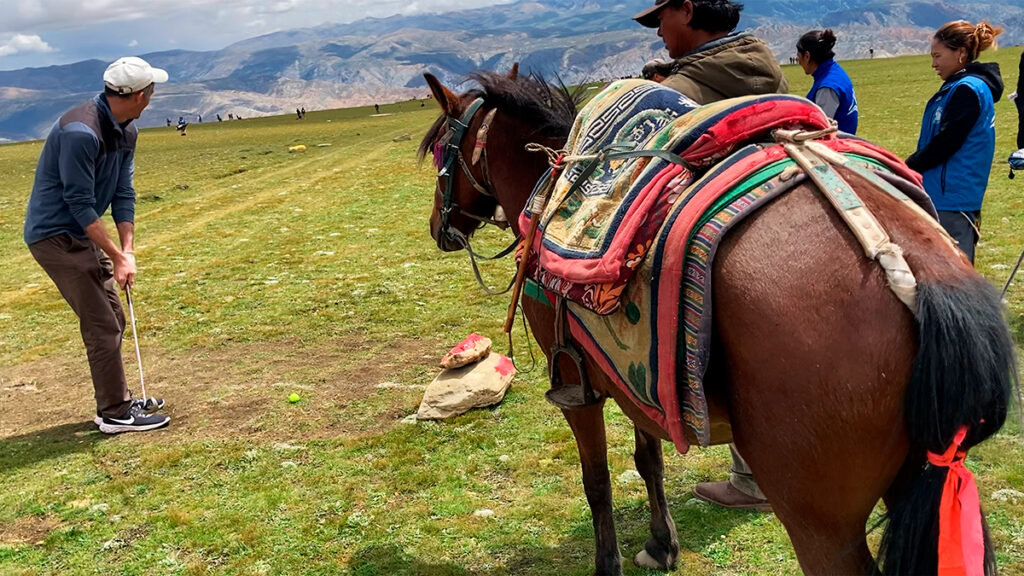
“When do the Jeeps leave?” Deepak Magar asked. We were gathered on Lo Manthang’s main drag. Throughout town, posters for Top of the World Golf Classic were pasted to walls. We took practice swings in DryJoys as cows wandered past us down the dirt road. If our scene didn’t already evoke a Salvador Dali circus, the tent opened five minutes later. Thirty-six women in traditional Tibetan clothing (plus a few Yankees and Dodgers caps) jumped from carts. “They’re from Lo Manthang,” Acharya said. “They’re caddieing for us today.”
Soon we were in a Jeep heading to our golf El Dorado. We rumbled through grassland and up a series of steep switchbacks, clipping over the edge
at 15,239 feet – finally at Mustang
Golf Course.
Tibetan tents were set up everywhere. Local women in yak-wool hats offered pastries in a breakfast line, smiling brightly. Little kids bounced on their parents’ laps. Everywhere there were golf bags, balls and golfers chipping into buckets. More locals arrived, scaling the 3,000-foot climb in the back of Jeeps, on motorbikes or on foot (a four-hour round-trip). Hundreds of locals were here to witness golf for the first time.
“OK, gather ’round everyone!” Acharya called in Nepali. Acharya’s colleague, Pashupati Sharma, handed out scorecards. Female elders presented each golfer with a white khata scarf (inscribed with Mustang Golf Course logo) for good luck. I received my scarf, clasping my hands together in the traditional prayer sign. If I played badly, I would have no excuses.
As Nepali news crews with cameras crowded, Thapa struck the ceremonial opening drive down the middle to raucous cheers. My group started on the seventh tee. One of my playing partners was Sonam Lama, owner of the Himalayan Yak Restaurant in Jackson Heights, Queens, New York. I nervously teed up on our 595-yard opening hole as my other playing partner, Shyam Tamang, wished me, “Best success.” My ball split the fairway. Someone shouted “Shotttttt!” I was already out of breath.
A round at Mustang is like playing on the edge of the world. The course is pancake flat – more so than I’d expected – but five of the nine holes hug steep drop-offs. On the first hole, with all trouble left, I watched Ibraj Uddin uncork a vicious hook, then attempt a brief but exciting ball retrieval with his caddie before his playing partners forced him to abort. Course conditions were rough – the greens a mix of grass and sand – but improvements are ongoing. The altitude made judging distances difficult. On some shots, the ball didn’t appear to fly any further. At the par-3 sixth, however, I hit a 9-iron 180 yards. Tees are marked with stones. The views of majestic mountain ranges are spectacular.
My favourite hole was the third, a 150-yard par 3 that featured a hole-in-one competition. The prize? A horse. Remarkably, the horse stood beside the tee, patiently waiting and wondering what was going on. It was a nice horse, but I worried it would make a tough prize to get through the ever-stringent airport TSA check. This concern became irrelevant when I overshot the green by 40 yards. I blamed the altitude. The whole round felt like a festival. The locals, including five Buddhist lamas in orange robes, roamed the fairways, causing constant shouts of “Ball!” which is Nepali for “Fore!”. Others zoomed up and down the course on motorbikes. My caddie, Toshi, a teenage student, was all-world nice. Before each of my shots, she whispered, “Best of luck.”

Tamang won the Stableford trophy, which made sense, because he somehow putted like Ben Crenshaw on the bumpy greens. As a crowd formed for the awards presentation, local dignitaries sat beside gold-plated trophies of horses and snow leopards. One by one, the Venerable Khenpo Tsewang Rinjing, a high-ranking chief lama, distributed World’s Highest Golf Course certificates. Rinjing announced me as the first American to play the course. (My 46 for nine holes was not announced.) We also learned that nobody won the horse.
A women’s group from Lo Manthang began a joyous dance performance. I thought once again of this marvellous Nepali spirit, of Gurkha fighters inspiring British soldiers with their courage, of Sherpas climbing high on Everest, putting their lives on the line to put food on the table. This same spirit had made Nepalis say, “Why not have the world’s highest golf course in this country? Why not come from Kathmandu in the middle of monsoon season to play the opening tournament?” All around me, a new chapter in the game of golf was being written.
Photographs by Subas Humagain
The Latest News
-
December 24, 2024North Lamar Australian Basketball
-
December 24, 2024We asked Golf Digest writers the story they were proudest of in 2024, and why – Australian Golf Digest
-
December 24, 2024Blueprint for success: how Australian architects made the world take notice in 2024
-
December 24, 2024‘Novak Djokovic will only care about the Australian Open and Wimbledon’
-
December 24, 2024PNG-Australia NRL Deal: K1.7 billion economic boost and 10,300 jobs expected


